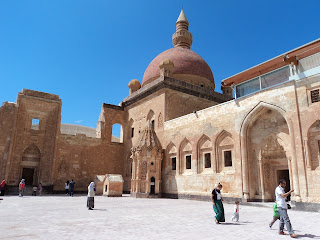5.30h
in the morning and the usual suspects’ fingers were already pointing to the
road. First destiny, Tatvan, on the west shore of Lake Van. It took just 3 cars
to make approximately 600km. It was not just luck, we are getting good at this...
With size and all the
architectonical differences aside, Tatvan view from and to the lake resembles a
little bit of Lausanne, in Switzerland, where my family lived for some years
before I was born. It is the best place to observe Mount Nemrut, the other one,
the volcano that (no one is sure how many) years ago erupted, blocking the surrounding
rivers and causing them to flood forming Lake Van, the biggest in Turkey.
 |
| Mount Nemrut |
 |
| With our host in Tatvan Eerda |
The plan was to go
from Tatvan to Van by the Ferryboat that makes that crossing every day, but
fortunately that day the only connection was at night, so we decided to go by
road, by the south side of the Lake. Fortunately because I know what to expect
from the Lake, but if we didn’t go by the road we didn’t know what we were
losing on the shore. On the way, Fafy covered the Lake on our left side and I
covered the landscape on our right.
 |
| Akdamar Island |
There is an ancient
Armenian proverb that says: "Van in this world, paradise in the next".
When we got there we understood why they used to say this. This huge city
managed to grow extending harmonically on the shore of its homonym Lake,
without almost any interference on its natural surroundings. Here the Lake is
always present, it’s part of the identity of the city.


Here there are Urartian cuneiform inscriptions dating to the 8th and 7th centuries BC. The next photo shows the biggest one that we found, and the one after a hand-made little sculpture of the Urartian alphabet deciphered, kindly showed by a German couple that we met there, and that explained us the whole story of this proto-Armenian kingdom and the citadel.
 |
| Best photo |
Due to its location near
the borders of the Persian, Russian and Ottoman Empire, Van has always played
an important role in the politics of the Ottoman Empire. There were conflicts
in this site and unfortunately the old and original Armenian citadel is in
ruins now.
 |
| Our host in Van, 29 years old, general manager of an enterprise already, my hero! |
On our way to Doğubeyazıt:
 |
| First glimpse of Ararat |
 |
| A sea of volcaninc stones |
Ishak Pasha Palace,
or as it is originally designated İshak Paşa Sarayı, is the last remaining
standing Ottoman palace in Anatolia. Its construction started in 1685 and took
one century to complete. It is located in a steep hill in the centre of the old
town. As it was built in an
era when castles were no more effective strongholds and firearms were developed
and were abundantly available, its defense towards the hills was not a priority.
Instead of being built to serve as a defense structure, it is one of the
wealthiest samples of Ottoman architecture. |
| Inscription of The Lion, a Turkish coloquial metaphor for man strength and bravery |
Next, photos of the ruins of the Doğubeyazıt Urartian castle.
 |
| Best photo #2 |
Doğubeyazıt has the
best view to Mount Ararat (Ağrı Dağı), and this is the closer we got to Iran and Armenia. The Mount is a dormant
volcanic cone with two peaks, Greater Ararat, 5 137m, the highest in Turkey,
and Little Ararat, with “just” 3 896m. It was first climbed in 1829 by Dr. Friedrich Parrot and Khachatur Abovian.
In Judeo-Christian
tradition, this place is associated with the "Mountains of Ararat"
where, according to the book of Genesis, Noah's ark came to rest after the
Great flood.
 |
| With "Fox Mehmet" |
 |
| Ararat in the morning |
 |
| I even got to drive! Apparently the only thing I wanted but won't do in Turkey is go to a football match |
The
landscapes change, the history of the places vary, but the pattern remains the
same, the people we meet are always extremely warm and our adventures are only
possible due to their will to help us. This travel had a constant: Blue. From
the Sky to the Land and in several tonalities. This color has been present all
my life. I lived all my life by the shore and here in Turkey I hadn’t before
seen so much of it.
Paco


















Nice information.
ReplyDeleteYou may also try
ISO 27001 Lead auditor Adana Turkey
ISO 27001 Lead implementer Training Adana Turkey
ISO 27001 Lead Auditor Gaziantep Turkey
ISO 27001 Lead Implementer Training Gaziantep Turkey